HYUNDAI NEXO 2023 Owners Manual
Manufacturer: HYUNDAI, Model Year: 2023, Model line: NEXO, Model: HYUNDAI NEXO 2023Pages: 558, PDF Size: 35.01 MB
Page 491 of 558
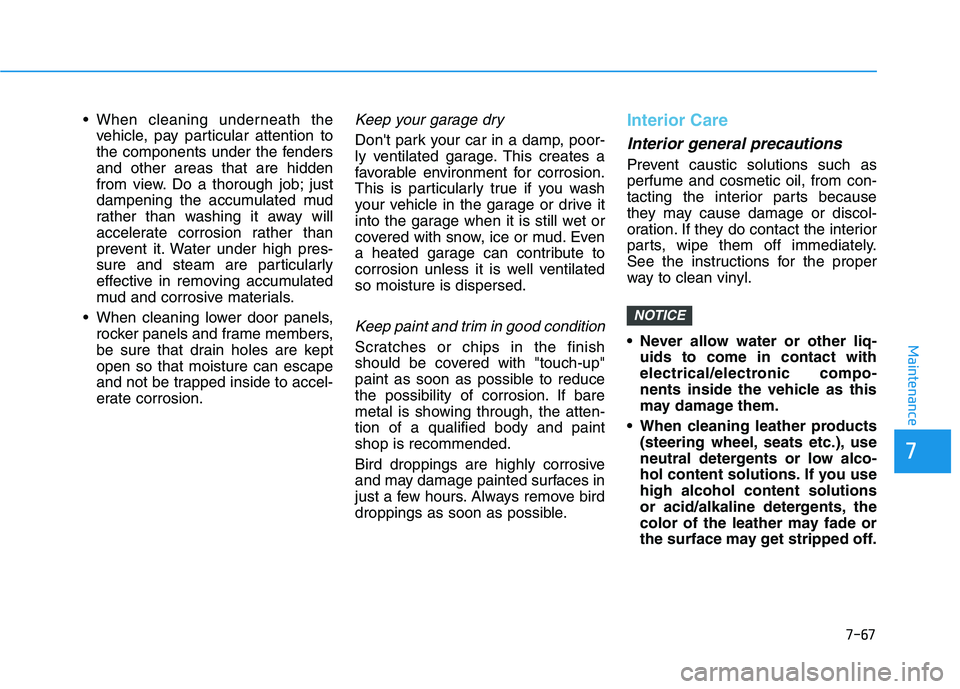
7-67
7
Maintenance
vehicle, pay particular attention to
the components under the fendersand other areas that are hidden
from view. Do a thorough job; just
dampening the accumulated mud
rather than washing it away will
accelerate corrosion rather than
prevent it. Water under high pres-
sure and steam are particularly
effective in removing accumulated
mud and corrosive materials.
When cleaning lower door panels, rocker panels and frame members,
be sure that drain holes are keptopen so that moisture can escape
and not be trapped inside to accel-
erate corrosion.Keep your garage dry
Don't park your car in a damp, poor-
ly ventilated garage. This creates a
favorable environment for corrosion.
This is particularly true if you wash
your vehicle in the garage or drive it
into the garage when it is still wet or
covered with snow, ice or mud. Even
a heated garage can contribute to
corrosion unless it is well ventilatedso moisture is dispersed.
Keep paint and trim in good condition
Scratches or chips in the finish
should be covered with "touch-up"
paint as soon as possible to reduce
the possibility of corrosion. If bare
metal is showing through, the atten-tion of a qualified body and paintshop is recommended.
Bird droppings are highly corrosive
and may damage painted surfaces in
just a few hours. Always remove bird
droppings as soon as possible.
Interior Care
Interior general precautions
Prevent caustic solutions such as perfume and cosmetic oil, from con-
tacting the interior parts because
they may cause damage or discol-
oration. If they do contact the interior
parts, wipe them off immediately.
See the instructions for the proper
way to clean vinyl.
Never allow water or other liq-uids to come in contact with
electrical/electronic compo-
nents inside the vehicle as this
may damage them.
When cleaning leather products (steering wheel, seats etc.), use
neutral detergents or low alco-
hol content solutions. If you usehigh alcohol content solutions
or acid/alkaline detergents, the
color of the leather may fade or
the surface may get stripped off.
NOTICE
Page 492 of 558
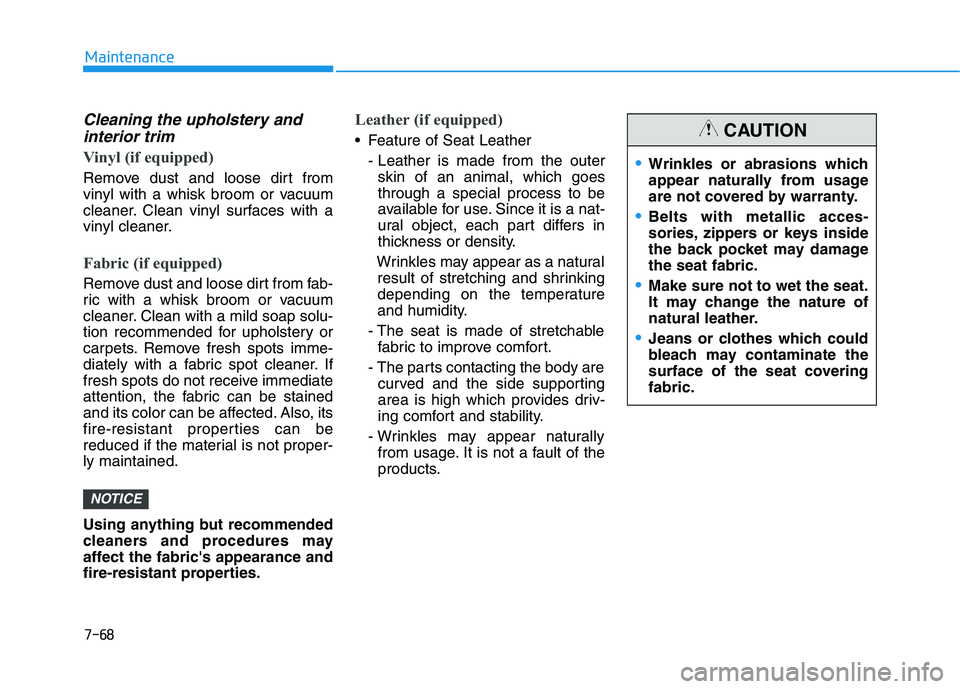
7-68
Maintenance
Cleaning the upholstery andinterior trim
Vinyl (if equipped)
Remove dust and loose dirt from
vinyl with a whisk broom or vacuum
cleaner. Clean vinyl surfaces with a
vinyl cleaner.
Fabric (if equipped)
Remove dust and loose dirt from fab-
ric with a whisk broom or vacuum
cleaner. Clean with a mild soap solu-
tion recommended for upholstery or
carpets. Remove fresh spots imme-
diately with a fabric spot cleaner. If
fresh spots do not receive immediate
attention, the fabric can be stained
and its color can be affected. Also, its
fire-resistant properties can be
reduced if the material is not proper-ly maintained.
Using anything but recommended
cleaners and procedures may
affect the fabric's appearance and
fire-resistant properties.
Leather (if equipped)
Feature of Seat Leather
- Leather is made from the outerskin of an animal, which goes through a special process to be
available for use. Since it is a nat-
ural object, each part differs in
thickness or density.
Wrinkles may appear as a natural result of stretching and shrinking
depending on the temperature
and humidity.
- The seat is made of stretchable fabric to improve comfort.
- The parts contacting the body are curved and the side supporting
area is high which provides driv-
ing comfort and stability.
- Wrinkles may appear naturally from usage. It is not a fault of the
products.
NOTICE
Wrinkles or abrasions which
appear naturally from usage
are not covered by warranty.
Belts with metallic acces-
sories, zippers or keys inside
the back pocket may damagethe seat fabric.
Make sure not to wet the seat.
It may change the nature of
natural leather.
Jeans or clothes which could
bleach may contaminate the
surface of the seat coveringfabric.
CAUTION
Page 493 of 558
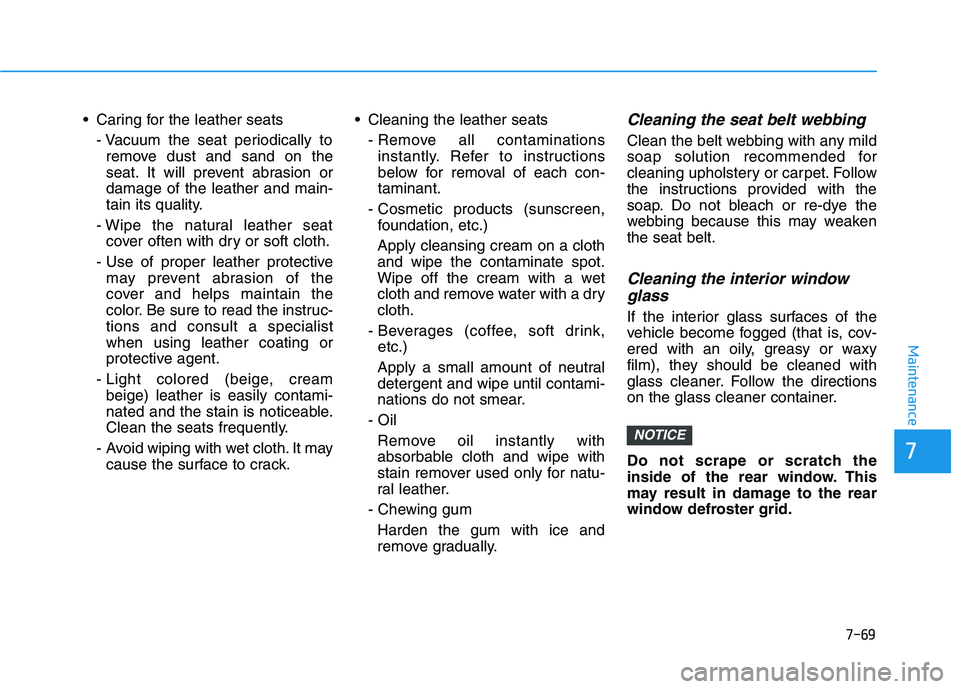
7-69
7
Maintenance
Caring for the leather seats- Vacuum the seat periodically toremove dust and sand on the
seat. It will prevent abrasion ordamage of the leather and main-
tain its quality.
- Wipe the natural leather seat cover often with dry or soft cloth.
- Use of proper leather protective may prevent abrasion of the
cover and helps maintain the
color. Be sure to read the instruc-tions and consult a specialistwhen using leather coating or
protective agent.
- Light colored (beige, cream beige) leather is easily contami-
nated and the stain is noticeable.
Clean the seats frequently.
- Avoid wiping with wet cloth. It may cause the surface to crack. Cleaning the leather seats
- Remove all contaminationsinstantly. Refer to instructions
below for removal of each con-taminant.
- Cosmetic products (sunscreen, foundation, etc.)
Apply cleansing cream on a clothand wipe the contaminate spot.
Wipe off the cream with a wet
cloth and remove water with a drycloth.
- Beverages (coffee, soft drink, etc.)
Apply a small amount of neutraldetergent and wipe until contami-
nations do not smear.
- Oil Remove oil instantly with
absorbable cloth and wipe with
stain remover used only for natu-
ral leather.
- Chewing gum Harden the gum with ice and
remove gradually.Cleaning the seat belt webbing
Clean the belt webbing with any mild
soap solution recommended for
cleaning upholstery or carpet. Follow
the instructions provided with the
soap. Do not bleach or re-dye the
webbing because this may weakenthe seat belt.
Cleaning the interior windowglass
If the interior glass surfaces of the
vehicle become fogged (that is, cov-
ered with an oily, greasy or waxy
film), they should be cleaned with
glass cleaner. Follow the directions
on the glass cleaner container.
Do not scrape or scratch the
inside of the rear window. This
may result in damage to the rear
window defroster grid.
NOTICE
Page 494 of 558
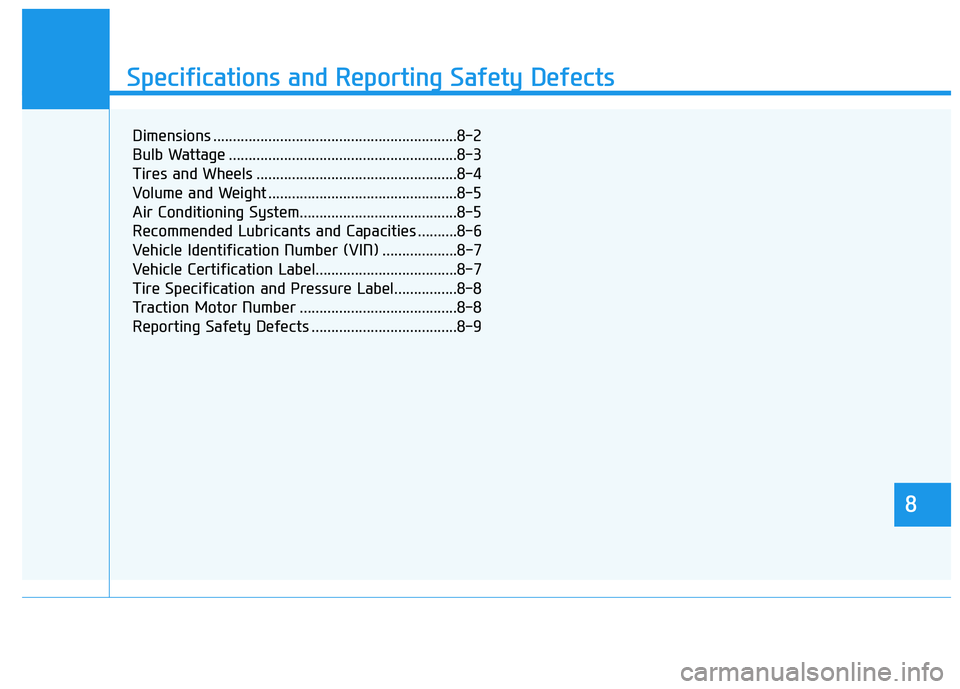
888
Specifications & Consumer information
8
Specifications and Reporting Safety Defects
8
Dimensions ..............................................................8-2
Bulb Wattage ..........................................................8-3
Tires and Wheels ...................................................8-4
Volume and Weight ................................................8-5
Air Conditioning System........................................8-5
Recommended Lubricants and Capacities ..........8-6
Vehicle Identification Number (VIN) ...................8-7
Vehicle Certification Label....................................8-7
Tire Specification and Pressure Label................8-8
Traction Motor Number ........................................8-8
Reporting Safety Defects .....................................8-9
Page 495 of 558
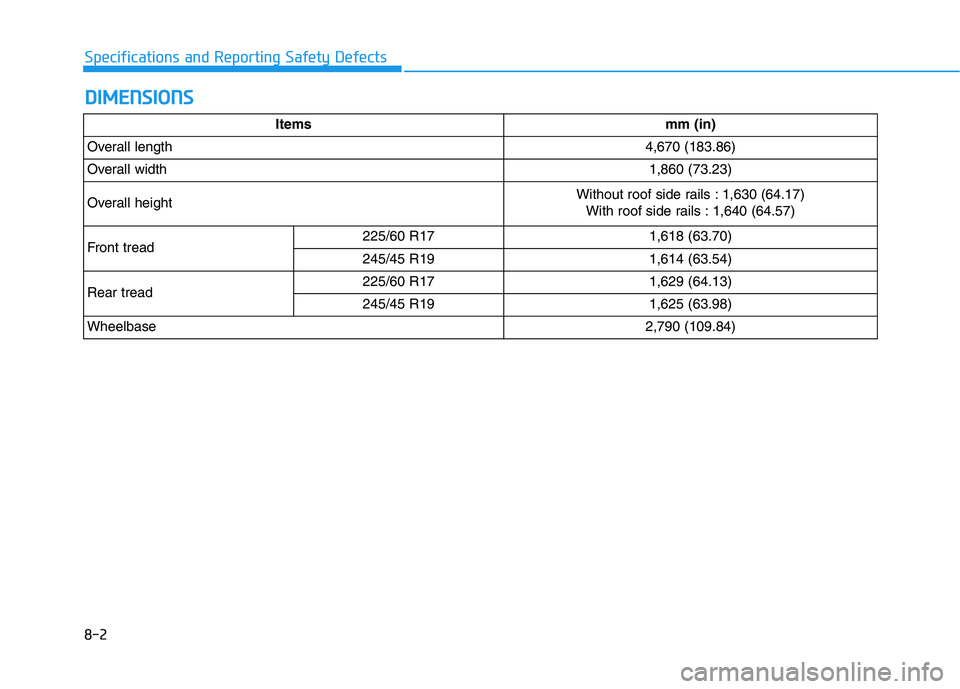
DDIIMM EENN SSIIOO NNSS
8-2
Specifications and Reporting Safety Defects
Itemsmm (in)
Overall length4,670 (183.86)
Overall width1,860 (73.23)
Overall heightWithout roof side rails : 1,630 (64.17)
With roof side rails : 1,640 (64.57)
Front tread225/60 R171,618 (63.70)
245/45 R191,614 (63.54)
Rear tread 225/60 R171,629 (64.13)
245/45 R191,625 (63.98)
Wheelbase2,790 (109.84)
Page 496 of 558
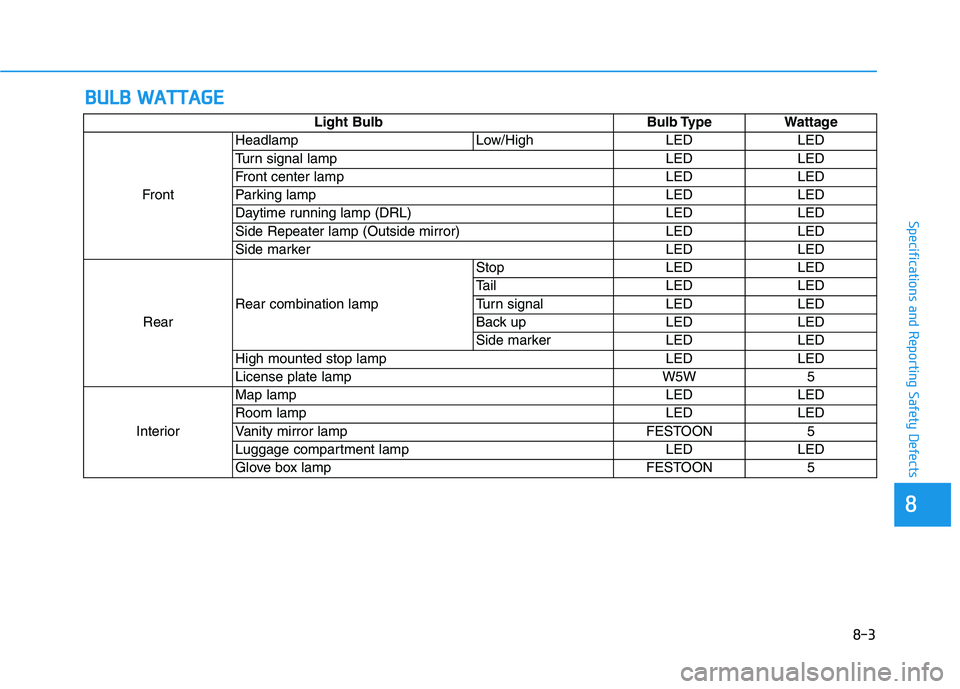
8-3
88
Specifications and Reporting Safety Defects
BBUU LLBB WW AATTTTAA GG EE
Light Bulb Bulb Type Wattage
Front Headlamp Low/High LED LED
Turn signal lamp LED LED
Front center lamp LED LED
Parking lamp LED LED
Daytime running lamp (DRL) LED LED
Side Repeater lamp (Outside mirror) LED LED
Side marker LED LED
Rear Rear combination lamp Stop LED LED
Tail LED LED
Turn signal LED LED
Back up LED LED
Side marker LED LED
High mounted stop lamp LED LED
License plate lamp W5W 5
Interior Map lamp LED LED
Room lamp LED LED
Vanity mirror lamp FESTOON 5
Luggage compartment lamp LED LED
Glove box lamp FESTOON 5
Page 497 of 558
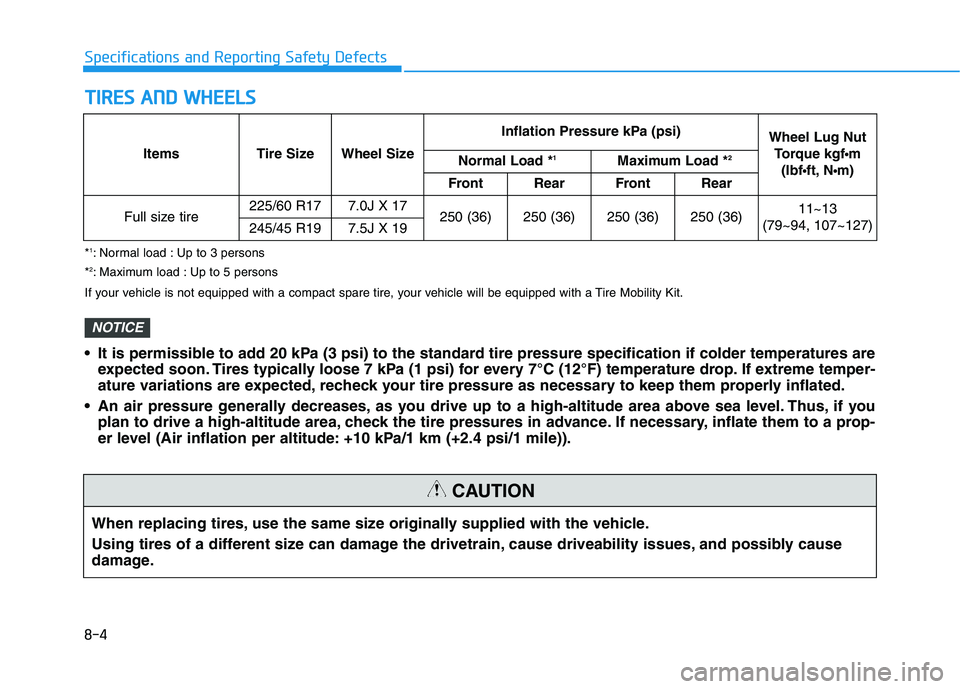
8-4
Specifications and Reporting Safety DefectsT
T IIRR EESS AA NN DD WW HHEEEELLSS
When replacing tires, use the same size originally supplied with the vehicle.
Using tires of a different size can damage the drivetrain, cause driveability issues, and possibly cause
damage.
CAUTION
If your vehicle is not equipped with a compact spare tire, your vehicle will be equipped with a Tire Mobility Kit.
Items Tire SizeWheel Size
Inflation Pressure kPa (psi)Wheel Lug Nut
Torque kgf •m
(lbf ft, N m)
Normal Load * 1Maximum Load * 2
FrontRearFrontRear
Full size tire225/60 R177.0J X 17250 (36)250 (36)250 (36)250 (36)11~13
(79~94, 107~127)
245/45 R197.5J X 19
It is permissible to add 20 kPa (3 psi) to the standard tire pressure specification if colder temperatures are expected soon. Tires typically loose 7 kPa (1 psi) for every 7°C (12°F) temperature drop. If extreme temper-
ature variations are expected, recheck your tire pressure as necessary to keep them properly inflated.
An air pressure generally decreases, as you drive up to a high-altitude area above sea level. Thus, if you plan to drive a high-altitude area, check the tire pressures in advance. If necessary, inflate them to a prop-
er level (Air inflation per altitude: +10 kPa/1 km (+2.4 psi/1 mile)).
NOTICE
*1
: Normal load : Up to 3 persons
* 2
: Maximum load : Up to 5 persons
Page 498 of 558
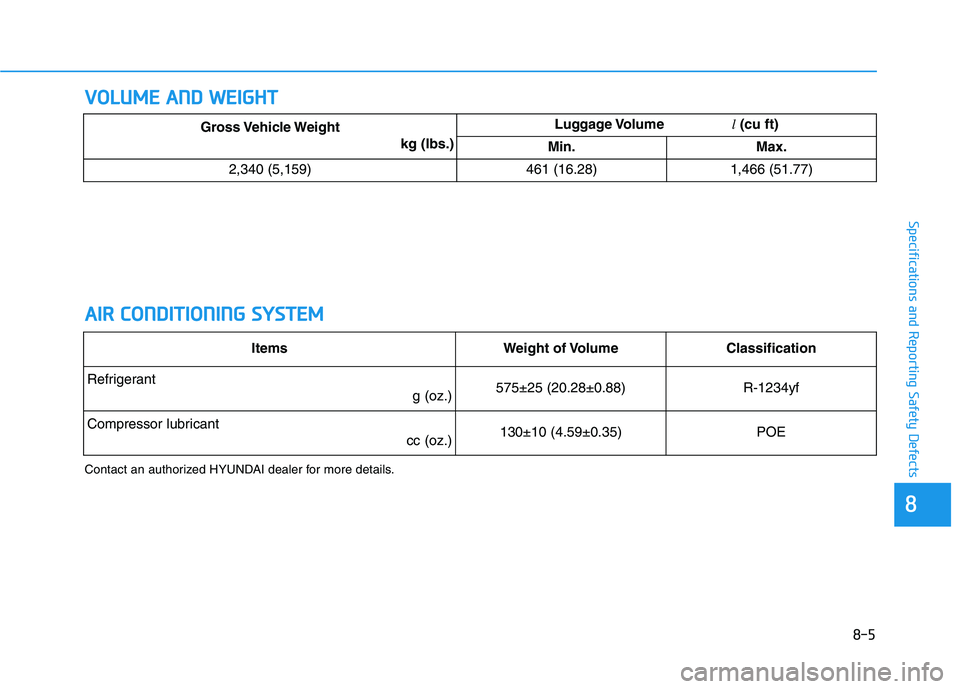
8-5
88
Specifications and Reporting Safety Defects
VVOO LLUU MM EE AA NN DD WW EEIIGG HH TT
A
A IIRR CC OO NNDDIITT IIOO NNIINN GG SS YY SSTT EEMM
Contact an authorized HYUNDAI dealer for more details.
Gross Vehicle Weight
kg (lbs.)Luggage Volume l(cu ft)
Min.Max.
2,340 (5,159)461 (16.28)1,466 (51.77)
ItemsWeight of VolumeClassification
Refrigerant
g (oz.) 575±25 (20.28±0.88)R-1234yf
Compressor lubricantcc (oz.) 130±10 (4.59±0.35)POE
Page 499 of 558
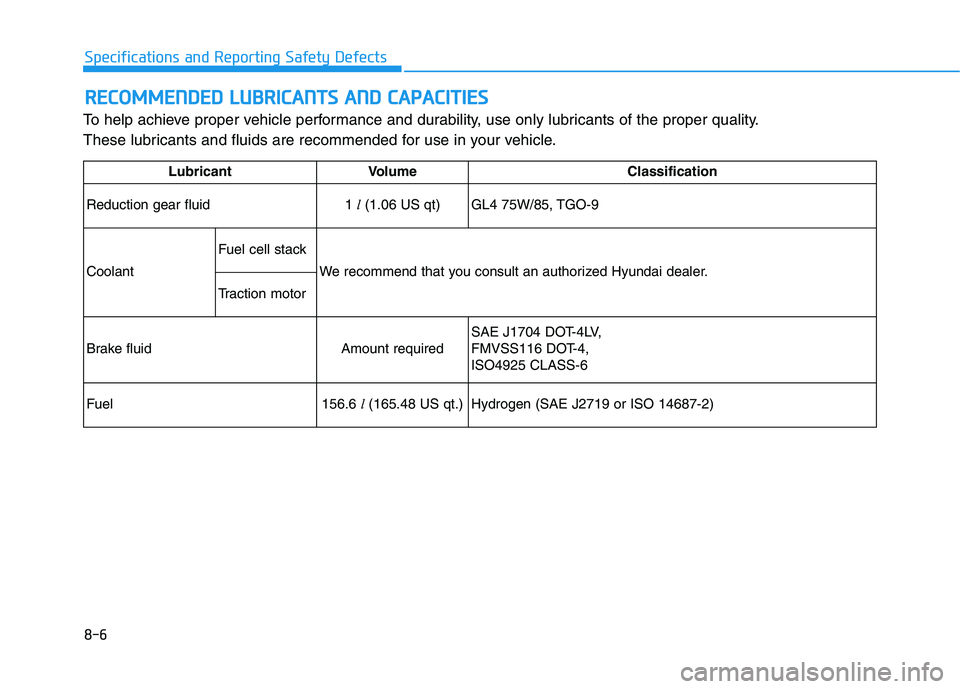
8-6
Specifications and Reporting Safety DefectsR
R EECCOO MM MMEENN DDEEDD LL UU BBRRIICC AA NN TTSS AA NN DD CC AA PPAA CCIITT IIEE SS
To help achieve proper vehicle performance and durability, use only lubricants of the proper quality.
These lubricants and fluids are recommended for use in your vehicle.
Lubricant Volume Classification
Reduction gear fluid 1
l(1.06 US qt)
GL4 75W/85, TGO-9
Coolant Fuel cell stack
We recommend that you consult an authorized Hyundai dealer.
Traction motor
Brake fluid Amount required SAE J1704 DOT-4LV,
FMVSS116 DOT-4,ISO4925 CLASS-6
Fuel 156.6
l(165.48 US qt.)
Hydrogen (SAE J2719 or ISO 14687-2)
Page 500 of 558
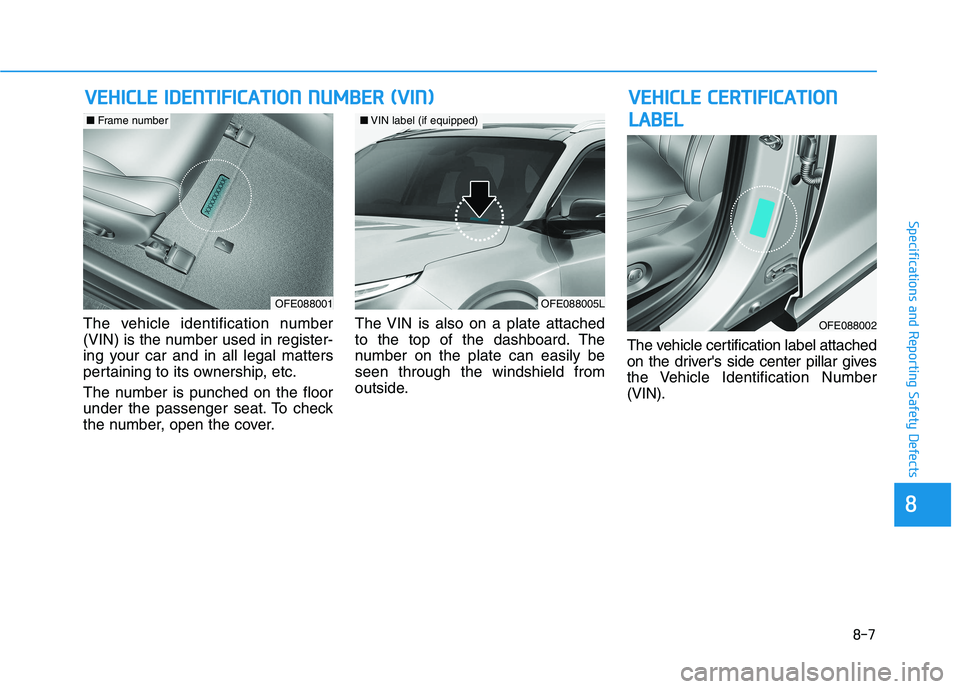
8-7
88
Specifications and Reporting Safety Defects
The vehicle identification number
(VIN) is the number used in register-
ing your car and in all legal matters
pertaining to its ownership, etc.
The number is punched on the floor
under the passenger seat. To check
the number, open the cover.The VIN is also on a plate attached
to the top of the dashboard. The
number on the plate can easily beseen through the windshield from
outside.
The vehicle certification label attached
on the driver's side center pillar gives
the Vehicle Identification Number(VIN).
VV
EEHH IICC LLEE IIDD EENN TTIIFF IICC AA TTIIOO NN NN UU MM BBEERR (( VV IINN ))
OFE088005L
■VIN label (if equipped)
OFE088001
■ Frame number
OFE088002
VV EEHH IICC LLEE CC EE RR TTIIFF IICC AA TTIIOO NN
L
L AA BBEELL